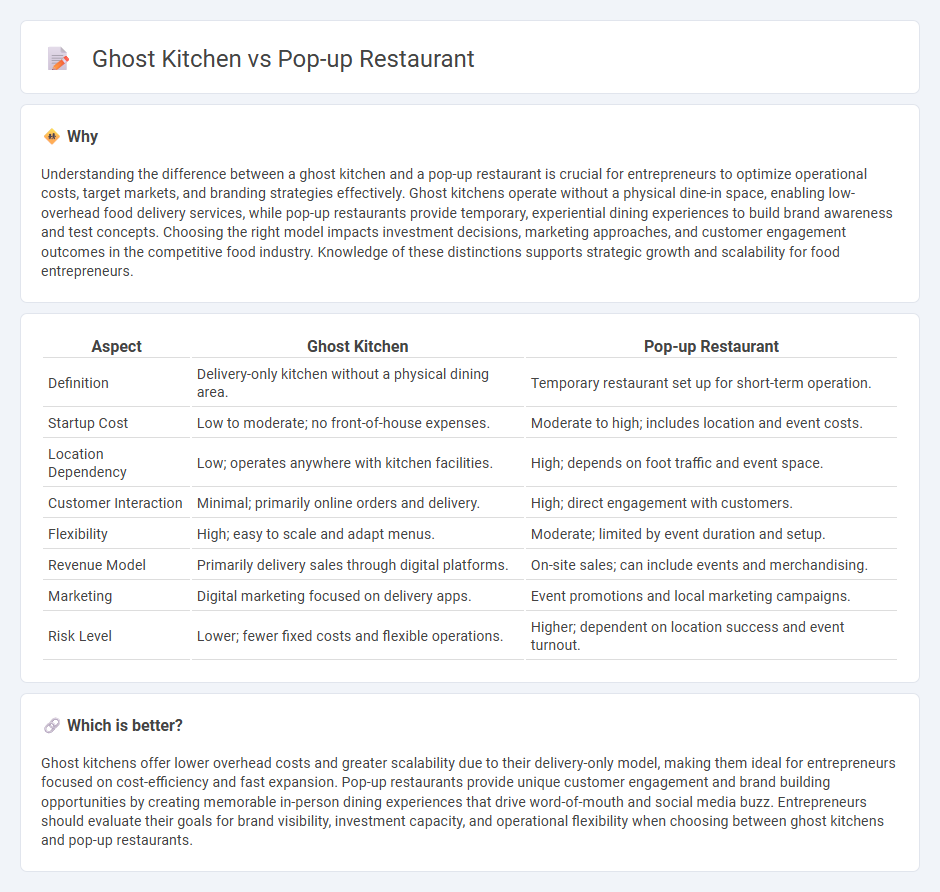
Ghost kitchens operate solely through online orders without a physical dine-in space, reducing overhead costs and allowing entrepreneurs to focus on delivery efficiency. Pop-up restaurants provide temporary, unique dining experiences in various locations, creating excitement and testing new markets without long-term commitments. Explore how these innovative models reshape the culinary entrepreneurship landscape.
Why it is important
Understanding the difference between a ghost kitchen and a pop-up restaurant is crucial for entrepreneurs to optimize operational costs, target markets, and branding strategies effectively. Ghost kitchens operate without a physical dine-in space, enabling low-overhead food delivery services, while pop-up restaurants provide temporary, experiential dining experiences to build brand awareness and test concepts. Choosing the right model impacts investment decisions, marketing approaches, and customer engagement outcomes in the competitive food industry. Knowledge of these distinctions supports strategic growth and scalability for food entrepreneurs.
Comparison Table
| Aspect | Ghost Kitchen | Pop-up Restaurant |
|---|---|---|
| Definition | Delivery-only kitchen without a physical dining area. | Temporary restaurant set up for short-term operation. |
| Startup Cost | Low to moderate; no front-of-house expenses. | Moderate to high; includes location and event costs. |
| Location Dependency | Low; operates anywhere with kitchen facilities. | High; depends on foot traffic and event space. |
| Customer Interaction | Minimal; primarily online orders and delivery. | High; direct engagement with customers. |
| Flexibility | High; easy to scale and adapt menus. | Moderate; limited by event duration and setup. |
| Revenue Model | Primarily delivery sales through digital platforms. | On-site sales; can include events and merchandising. |
| Marketing | Digital marketing focused on delivery apps. | Event promotions and local marketing campaigns. |
| Risk Level | Lower; fewer fixed costs and flexible operations. | Higher; dependent on location success and event turnout. |
Which is better?
Ghost kitchens offer lower overhead costs and greater scalability due to their delivery-only model, making them ideal for entrepreneurs focused on cost-efficiency and fast expansion. Pop-up restaurants provide unique customer engagement and brand building opportunities by creating memorable in-person dining experiences that drive word-of-mouth and social media buzz. Entrepreneurs should evaluate their goals for brand visibility, investment capacity, and operational flexibility when choosing between ghost kitchens and pop-up restaurants.
Connection
Ghost kitchens and pop-up restaurants revolutionize entrepreneurship by minimizing overhead costs and maximizing flexibility in the food service industry. Both business models leverage temporary and scalable operations to test markets and adapt quickly to consumer preferences, driving innovation and reducing traditional restaurant risks. Entrepreneurs utilize these concepts to optimize resource allocation while experimenting with unique culinary concepts and expanding brand presence efficiently.
Key Terms
Temporary Space
Pop-up restaurants utilize temporary physical spaces to create unique, immersive dining experiences that attract local customers and generate buzz quickly. Ghost kitchens operate without a storefront, focusing solely on food delivery from commercial kitchen spaces optimized for efficiency and scalability. Explore more to understand how these innovative models reshape the restaurant industry and consumer preferences.
Delivery-Only Model
Pop-up restaurants offer temporary, physical dining experiences with a limited menu, while ghost kitchens operate exclusively for delivery and online orders, maximizing efficiency and reducing overhead costs. Delivery-only models in ghost kitchens leverage advanced technology and data analytics to optimize order processing, food preparation, and customer reach. Discover how these innovative concepts reshape the food service industry and enhance convenience.
Customer Experience
Pop-up restaurants offer immersive dining experiences with direct customer interaction, showcasing limited-time menus and unique ambiance that enhance engagement and brand loyalty. Ghost kitchens prioritize convenience and efficiency, delivering diverse menus through online platforms without physical dining spaces, often impacting personalized service and ambiance. Explore how these models reshape customer experience in the evolving food industry.
Source and External Links
Pop-up restaurant - Wikipedia - A pop-up restaurant is a temporary dining venue that operates in unconventional spaces like private homes or former factories, popular since the 2000s as a way for chefs to experiment and gain exposure without the risks of permanent establishments.
What Is a Pop-Up Restaurant & How To Start One | UpMenu - Pop-up restaurants are temporary and often mobile food venues that operate in unexpected spaces, using social media to attract customers and offering a variety of dining experiences from casual to upscale.
What is a Pop-Up Restaurant & How to Open One - Toast POS - Pop-up restaurants can vary widely in format and purpose, from testing new food concepts in limited engagements to providing career growth opportunities for chefs, frequently utilized in existing venues during off-hours or in partnership with established restaurants.
 dowidth.com
dowidth.com